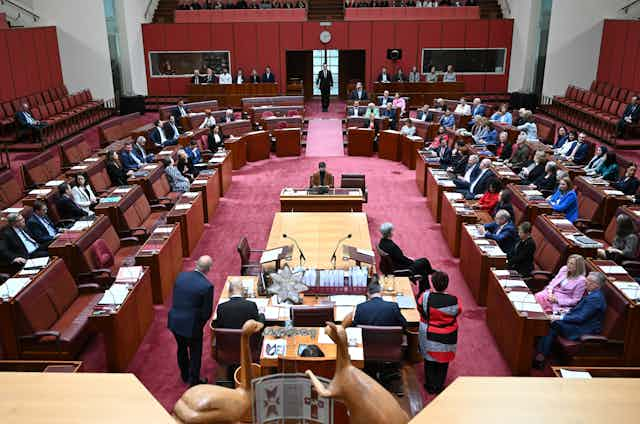The legislation to enable the Australian people to vote in a referendum for an Indigenous Voice to Parliament has passed the Senate by 52 to 19.
The vote took place with the public gallery crowded with supporters, and was greeted with prolonged applause. Those watching included prominent leaders of the “yes” campaign, including Megan Davis, Pat Anderson and Thomas Mayo.

But Indigenous crossbencher Lidia Thorpe labelled it “assimilation day” and interjected repeatedly during the debate on the bill’s third reading, and during the applause.
Those who voted against the legislation will be involved in preparing the no case for the yes/no pamphlet that will be sent to all voters.
Earlier, Nationals leader David Littleproud told the ABC he did not support having the claim the Voice would “re-racialise” Australia – a claim Opposition Leader Peter Dutton has made – included in the pamphlet’s no case. “I don’t support those sort of words. I’m not prepared to put my weight behind those words,” he said.
The government has not announced a date for the vote yet.
The referendum legislation required an absolute majority, so every vote was recorded.
In the final round of speeches in the Senate, shadow Attorney-General Michaelia Cash said “we are opening up a legal can of worms. The proposed model […] is not just to the parliament but to all areas of executive government. It gives an unlimited scope.”
Opposition spokeswoman for Indigenous Australians Jacinta Nampijinpa Price said the Voice would divide the country.
Greens Senator Dorinda Cox said the Greens “remain committed to the full implementation of the Uluru Statement from the Heart, truth, treaty and voice. The referendum is the first important step.”
ACT crossbencher David Pocock said the Voice was “about ensuring that First Nations people, Australia’s first peoples, have a say on issues that affect them”.
Thorpe declared: “Happy assimilation day”. She said the Voice was “appeasing white guilt in this country by giving the poor little blackfellas a powerless advisory body”. She would be voting no to something that gave no power.
“"There is not one law in this country that has ever, ever, ever been good for us, not one. And now we’re meant to accept a powerless voice. It is truly assimilating our people so we’ll fit nicely as your little Indigenous Australians, it’s what you want us to be, right?”
She was asked by Senate President Sue Lines to cover her T-shirt, which had “gammin” in it, used in Aboriginal slang to mean fake.
Pauline Hanson said many people were still very confused about the proposal.
Assistant Minister for Indigenous Australians Malarndirri McCarthy said “this is a critical moment in our country’s history. It is the right thing to do.” McCarthy paid tribute to Senator Patrick Dodson, who is on extended leave due to illness.
Murray Watt, representing the Attorney-General, called for the coming debate to be respectful, saying there was an onus on people to “tell the truth” and accusing no supporters of misinformation.
Appearing after the legislation passed parliament, at a news conference with Indigenous leaders, Anthony Albanese pitched a strong appeal to voters: “I say to my fellow Australians: parliaments pass laws, but it is people that make history.
"This is your time, your chance, your opportunity to be a part of making history,” he said. It was a “once-in-a-lifetime opportunity to lift our great nation even higher”.
Referencing Labor’s recent historic victory at the Aston byelection, the PM said this was “more important than any by-election ever held”.
Liberal MP Julian Leeser, who quit as shadow minister for Indigenous Australians to support the yes case, said in a statement after the vote: “Over the months ahead, I am looking forward to being part of a movement of Australians from all political backgrounds and playing a part in a campaign that will bring our country together”.

